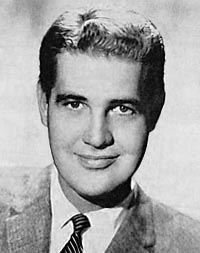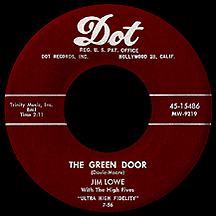JIM LOWE
The Green Door
The music career of Missouri-born disc jockey Jim Lowe branched out into country music, big band-style pop, rhythm and blues and novelty recordings. Possessing a deep baritone on-air delivery, he could carry a tune as well and had little trouble getting a contract as a singer with Mercury Records in 1953. He composed his first single, "Gambler's Guitar," and within a couple of weeks fellow Mercury artist Rusty Draper had done his own version. Rusty's reading of lines like 'Tell all the folks that this life's a game of poker...a fool and his gold must part...' with the deliriousness of one who knew the drill first-hand, caught on with the public, reaching the top ten that summer while effectively shutting Lowe's original out of contention. Consolation prize: writer's royalties!
After three more singles including a Christmas song, Autryesque western throwback "Santa Claus Rides a Strawberry Roan," he left Mercury none the worse for wear thanks to his day job at Chicago's WMAQ. About a year later he signed with Randy Wood's Dot Records and took a different approach with his debut single for the label in the summer of '55. On The Tonight Show, Steve Allen had been blatantly marketing the Goo-Goo Doll, an annoying children's toy, and had recorded his own novelty single titled, appropriately, "Goo-Goo Doll," on the Coral label, complete with distracting use of the obnoxious noise the squeeze toy made (termed "the dizzy doll sound gimmick" in a Billboard magazine review). Lowe got in on the act with "Close the Door," a Fred Ebb-Paul Klein tune employing the same sound effect in a nightmare tale of multiplying Goo-Goos ('Comin' in the window...runnin' up the stairs...hangin' on the ceiling...soon I was a-standin' in 'em, right up to my knees!')...YIKES!
So it was back to the drawing board when that idea didn't work (the song, that is; seems the creepy dolls sold quite well). Chuck Berry's "Maybellene," an early indicator of the rock and roll invasion (far preferable to the Goo-Goo Doll infestation), was tearing up the charts that summer and Lowe waxed his own version, skirting the lower edge of the R&B chart (of all places) in the process (over on the country side, Marty Robbins was having success with his fiddle-infused cover of Chuck's confrontation with his fickle automobile). Lowe figured to stick with a good thing, laying down a cover of "Blue Suede Shoes," but rock and roll just wasn't his forte; it's hard to imagine Carl Perkins, nice guy that he was, approving of Lowe's lackluster rendition.

1956 turned out to be a big year for Jim, starting with a move to New York City and a slot on WCBS. Marvin Moore and Bob Davie (later a recording artist and producer using the name Hutch Davie) came up with a song called "The Green Door," inspired by an after hours joint Moore had been to in Dallas where he recalled a mysterious room requiring a password to get in (gambling? women? free-flowing liquor? other forbidden pleasures one can only guess at?)...so near and yet so far! The two set to work laying down individual tracks for the song, in the way Les Paul had built his reputation a few years earlier. Davie, desiring a honky tonk sound, put thumbtacks in the hammers of his Steinway piano and sped up the tape on that track for a novel sound; Lowe's vocals ('...saw an eyeball peepin' through a smoky cloud behind the green door...') were added at the end of the recording process. Pay dirt! The record, with backing vocals by session singers The High Fives, caught on fast in the fall of '56, wedging itself between two Elvis blockbusters ("Don't Be Cruel" and "Love Me Tender") to spend a few weeks at number one in November.
Things went well for awhile after that; "I Feel the Beat" and "By You, By You, By You," both written by Davie and Moore, had separate chart runs in early '57. A successful two-sider came next: ballad "Four Walls," penned by Moore and George Campbell, competed admirably with a breakthrough country version by Jim Reeves. Its flip side, "Talkin' to the Blues" (devised by Lowe and Moore), may well be Jim Lowe's best song, delivered with all the tobacco-and-whiskey-throated conviction of a guy experiencing the aftermath of finally making it behind the green door ("...ol' buddy blues, take my last cigarette...you doggg...') with some romantic heartbreak thrown in for good measure. Both sides hit the top 20 in the spring of 1957.
Nine more singles for Dot Records, covering a variety of musical sources, all came up short. Jim Lowe's contract ended in 1960, leaving him in the not-so-uncomfortable position of top New York City radio personality. He moved around a bit, logging time at WRCA, WNEW and WNBC, where for several years he was a key component in the NBC radio network's ambitious Monitor, a weekend-long news/variety series (sort of a marathon radio version of The Today Show). He made records for various labels from time to time, among them "Hootenanny Granny," a 1963 novelty tune set to the public domain melody of Woody Guthrie's "This Land is Your Land." Settling in back at WNEW, he stayed there from the early 1970s until his retirement from radio in the early '90s. Maybe he still visits that curiously compelling room, wherever it may be. If you should find it, don't say "Joe sent me"...you'll just hear someone laugh out loud behind "The Green Door."


